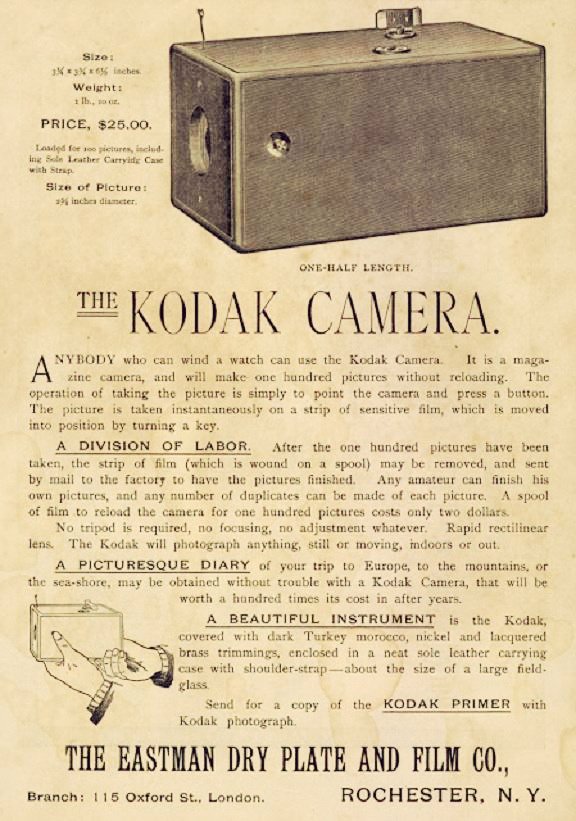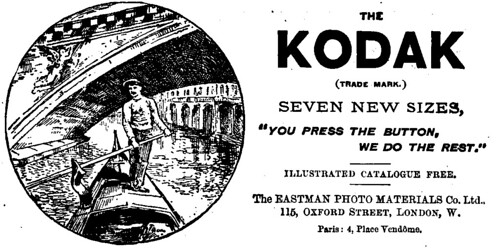Difference between revisions of "Kodak Camera"
(Created page with " {{Flickr_image |image_source= |image= |image_align= |image_text= Eastman Co.'s advertisement for the Kodak Camera |scan_by= Roy Sutherland |image_rights= (c) }} As simpl...") |
(image reused) |
||
| (One intermediate revision by the same user not shown) | |||
| Line 1: | Line 1: | ||
{{Flickr_image | {{Flickr_image | ||
| − | |image_source= | + | |image_source= https://www.flickr.com/photos/144518485@N02/46583066942/in/pool-camerawiki/ |
| − | |image= | + | |image= http://farm5.staticflickr.com/4837/46583066942_40a0444117_o_d.jpg |
| − | |image_align= | + | |image_align= right |
|image_text= Eastman Co.'s advertisement for the Kodak Camera | |image_text= Eastman Co.'s advertisement for the Kodak Camera | ||
|scan_by= Roy Sutherland | |scan_by= Roy Sutherland | ||
| Line 9: | Line 9: | ||
}} | }} | ||
| − | As simple as possible. That was the conception of the '''Kodak Camera'''. The wooden [[box camera]] used a special film on paper roll. After 100 exposures the whole camera had to be sent to the Eastman Dry Plate and Film Company in [[Rochester]] where the negative film was developed and image prints were made from the negatives. Then the pictures and the camera (reloaded with new film) was sent back to its owner! | + | As simple as possible. That was the conception of the '''Kodak Camera'''. The wooden [[box camera]] used a special film on paper roll. After 100 exposures the whole camera had to be sent to the [[Eastman|Eastman Dry Plate and Film Company]] in [[Rochester]] where the negative film was developed and image prints were made from the negatives. Then the pictures and the camera (reloaded with new film) was sent back to its owner! The top slogan to sell the expensive box camera was "You press the button, we do the rest." |
| − | The 25$ [[box camera]] of 1888 was Eastman's first step towards finally popularizing photography with simple 1$ Kodak [[rollfilm]] box cameras in the year 1900, in vibrant concurrence to other camera makers who then also popularized traditional glass plate photography with simple box cameras. The Kodak Camera soon had been succeeded by the almost similar [[Kodak No.1]] in 1889. | + | The 25$ [[box camera]] of 1888 was Eastman's first step towards finally popularizing photography with simple 1$ Kodak [[rollfilm]] box cameras in the year 1900, in vibrant concurrence to other camera makers who then also popularized traditional glass plate photography with simple box cameras. The Kodak Camera soon had been succeeded by the almost similar [[Kodak No. 1]] in 1889. |
| + | |||
| + | {{Flickr image | ||
| + | | image_source=http://www.flickr.com/photos/89864432@N00/3711060188/in/pool-camerawiki | ||
| + | | image=http://farm3.static.flickr.com/2435/3711060188_504e2c03f4.jpg | ||
| + | | image_align= center | ||
| + | | image_text= The ''Kodak Camera'' soon became an international product. This is an advertisement of Eastman's British branch [[Kodak Ltd.|Eastman Photo Materials Co. Ltd.]] from 1891, citing Eastman Company's original service motto. The sketched photo subject "Gondola" as illustration refers to the fact that the images shot with a Kodak Camera had been round! | ||
| + | | scan_by=Uwe Kulick | ||
| + | | image_rights=with permission | ||
| + | }} | ||
[[Category:1839-1889]] | [[Category:1839-1889]] | ||
[[Category:Kodak]] | [[Category:Kodak]] | ||
[[Category:box]] | [[Category:box]] | ||
Latest revision as of 09:48, 15 January 2019

|
| Eastman Co.'s advertisement for the Kodak Camera scanned by Roy Sutherland (Image rights) |
As simple as possible. That was the conception of the Kodak Camera. The wooden box camera used a special film on paper roll. After 100 exposures the whole camera had to be sent to the Eastman Dry Plate and Film Company in Rochester where the negative film was developed and image prints were made from the negatives. Then the pictures and the camera (reloaded with new film) was sent back to its owner! The top slogan to sell the expensive box camera was "You press the button, we do the rest."
The 25$ box camera of 1888 was Eastman's first step towards finally popularizing photography with simple 1$ Kodak rollfilm box cameras in the year 1900, in vibrant concurrence to other camera makers who then also popularized traditional glass plate photography with simple box cameras. The Kodak Camera soon had been succeeded by the almost similar Kodak No. 1 in 1889.

|
| The Kodak Camera soon became an international product. This is an advertisement of Eastman's British branch Eastman Photo Materials Co. Ltd. from 1891, citing Eastman Company's original service motto. The sketched photo subject "Gondola" as illustration refers to the fact that the images shot with a Kodak Camera had been round! scanned by Uwe Kulick (Image rights) |